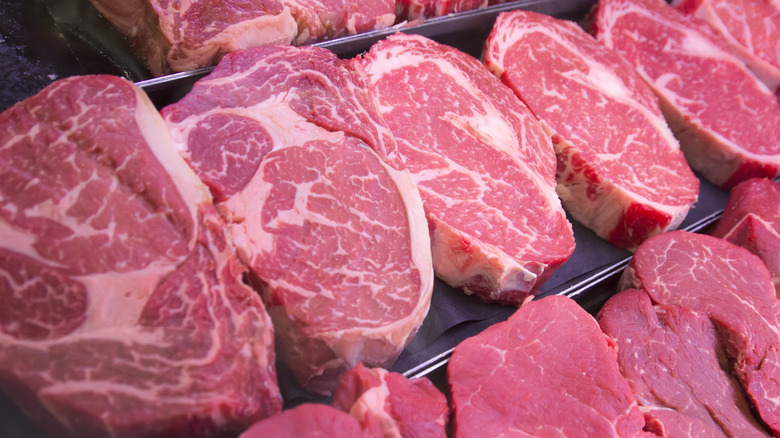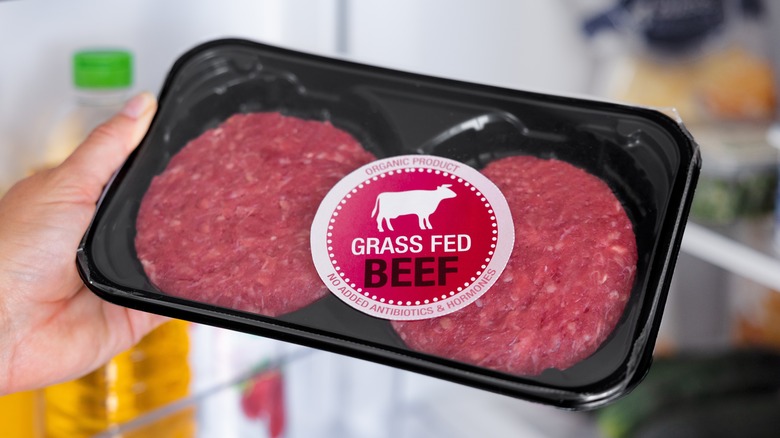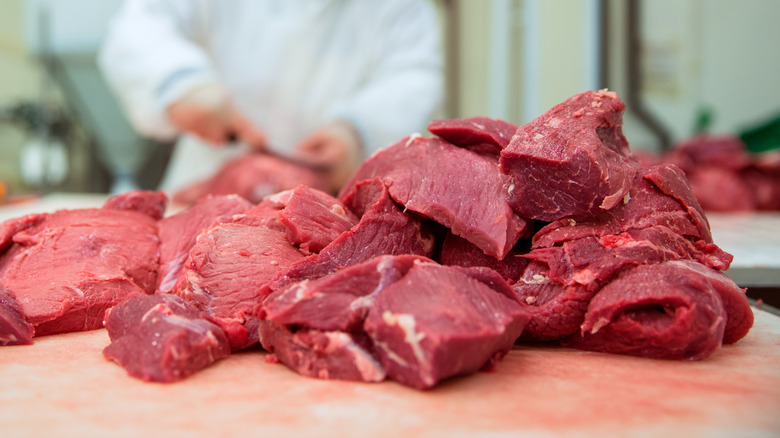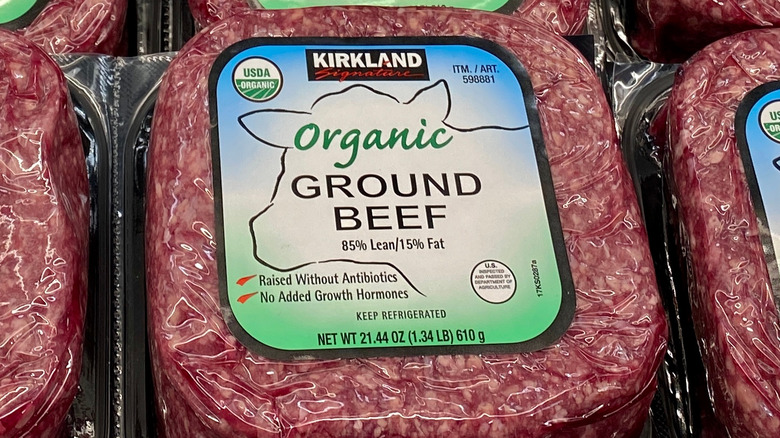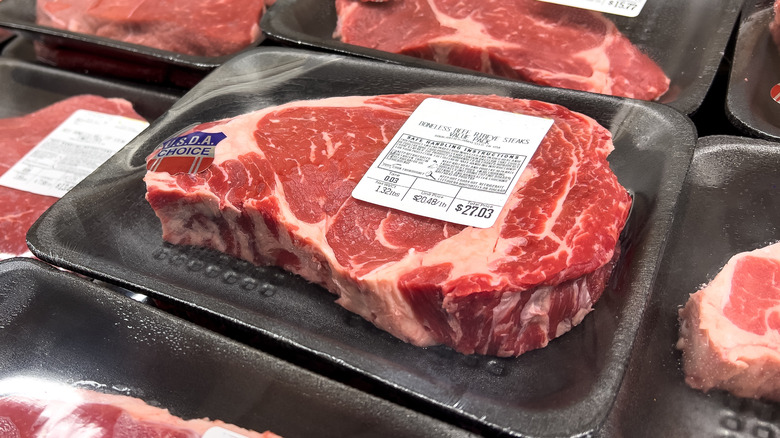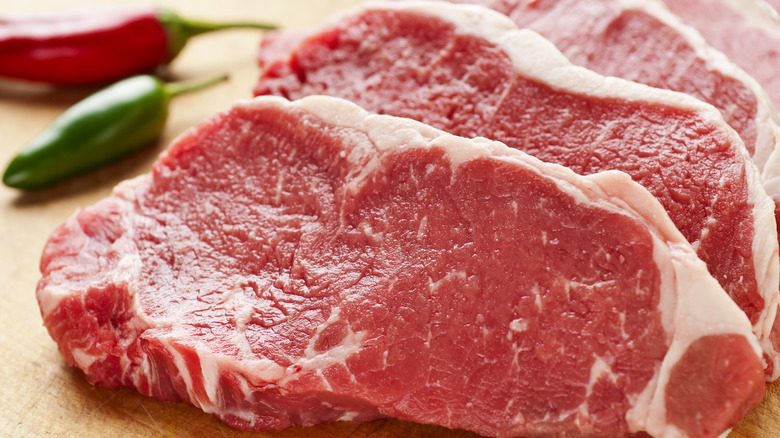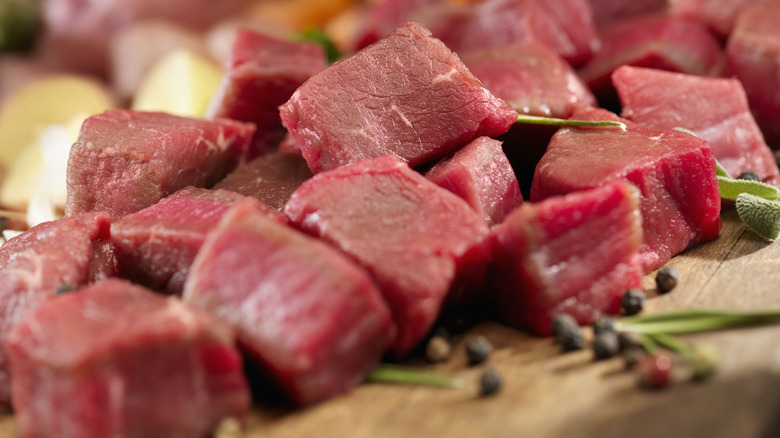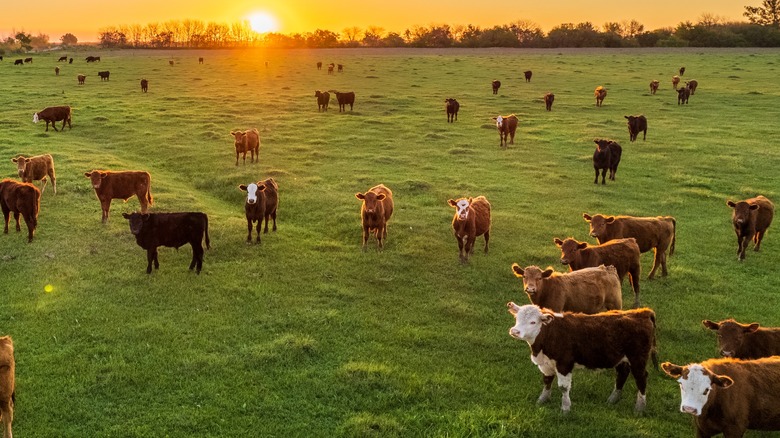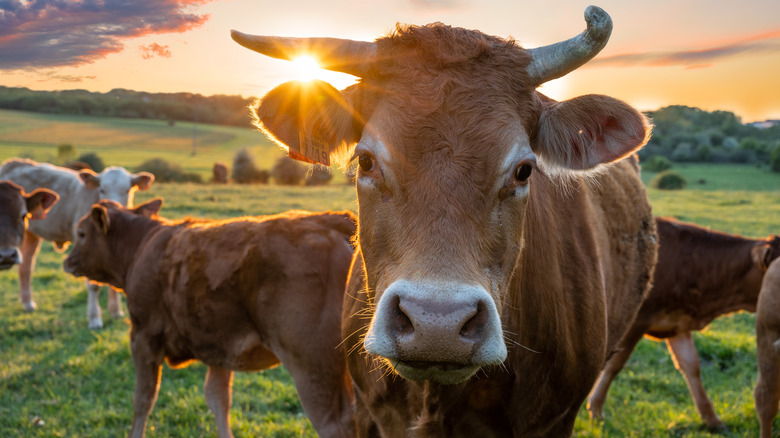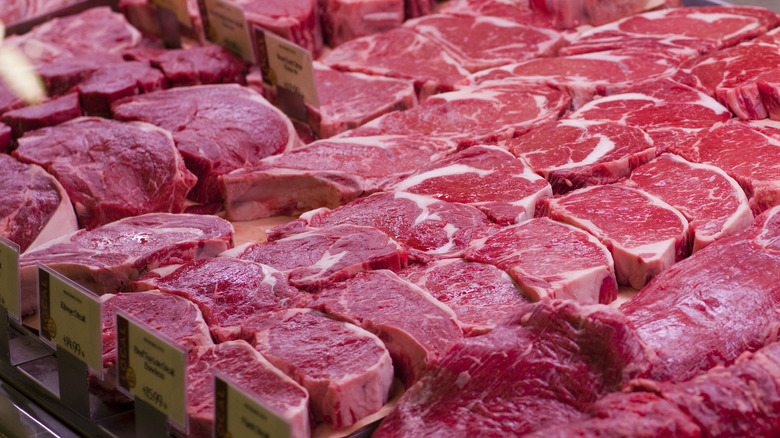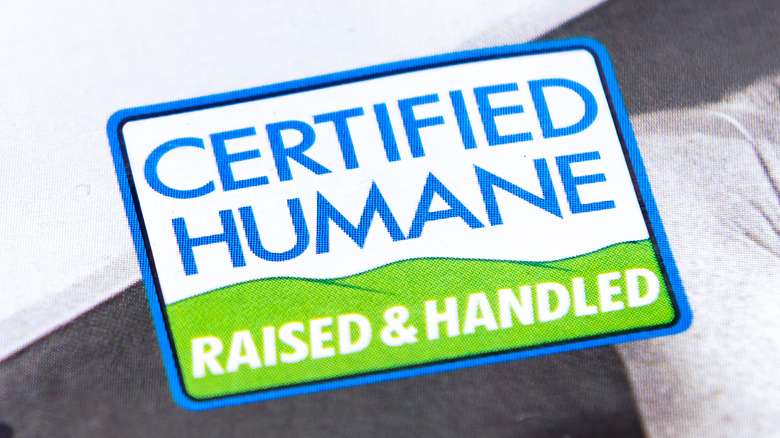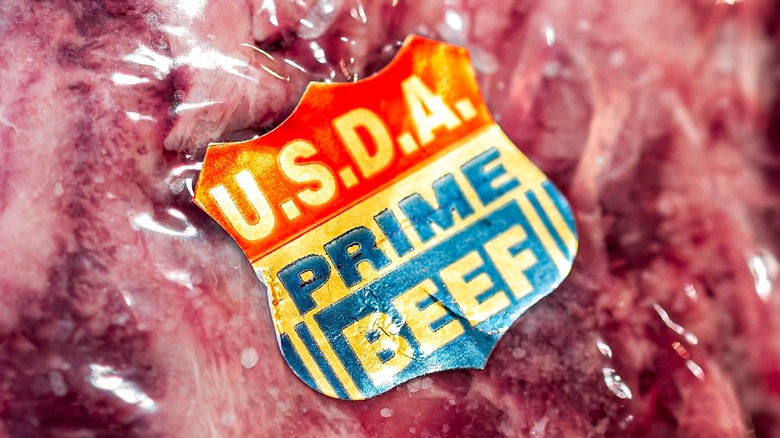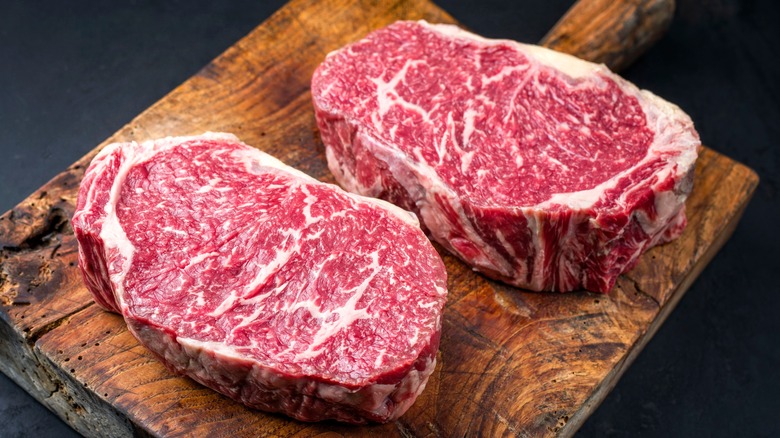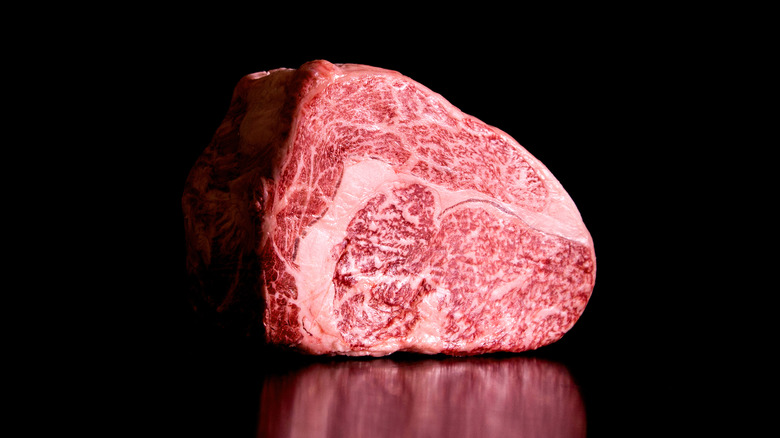Common Phrases On Beef Packages And What They Mean
Beef is a versatile and delicious ingredient that is a staple in many households across the country. Whether you're looking to purchase ground beef for cheeseburgers, a roast for a special occasion, or a steak for the grill, the packaging on beef often offers a wealth of information that can be confusing. With more shoppers looking to invest in high-quality meat that is in line with humane practices and promotes healthier living, it seems there are more labels on meat packages than ever before.
But what exactly does it all mean? Are labels like "organic," "grass-fed," and "raised without antibiotics or hormones" actually signs of better beef? How can consumers know that the labels they see on beef are verified and not just claims on the part of producers for the sake of advertising?
We've done the research for you so the next time you head to your local grocer's butcher department, you know precisely what to look for.
Grass-fed refers to the animal's diet
A common label in the meat market is "grass-fed." This means that the animal ate grasses and forage after it fed on its mother's milk in its early life. Although it may seem that the "grass-fed" label suggests the animal was never given grain, it's important to know that only beef labeled as "100% grass-fed" means the animal exclusively ate grass and forage, like hay. This is an important distinction from simply being labeled "grass-fed," a qualification nearly all cattle would technically meet, even if they had been fed grain for some, or most, of their lifetime.
The Food Safety and Inspection Service (FSIS) of the U.S. Department of Agriculture (USDA) regulates beef producers claiming to be grass-fed via an audit. The verification of grass-fed practices is thought to be not strictly enforced, as audits are performed in an office rather than on-site.
In terms of nutrition, grass-fed beef doesn't provide significantly better nutritional value compared with grain-fed beef. However, grass-fed beef does provide slightly more omega-3 fatty acids, albeit not enough to make a meaningful impact.
USDA Process Verified seal signifies a voluntary verification process
You've likely seen the "USDA Process Verified" seal on packages of beef. This seal is not a specific claim in and of itself. According to the USDA, this seal indicates that a service has been enacted to verify the claims the producers are using to market their products to customers. Producers voluntarily pay to have their practices, be it that they are antibiotic-free or adhere to specific agricultural practices, verified via an independent auditor.
Shoppers should know that a "USDA Process Verified" label does not serve as an indicator of beef quality or animal welfare. All the "USDA Process Verified" seal indicates is that the procedures identified by the producers are actually occurring. It doesn't mean the producer has met other regulatory standards unless the package has other seals or labels that confirm those regulations separately.
What this means is that to qualify for the "USDA Process Verified" seal, producers can determine on their own what standards they must meet to make a specific claim. So, the verification process only confirms they are meeting the standards they have written and not those of the USDA or other independent meat quality or animal welfare organizations.
USDA Organic beef follows strict standards
When buying organic produce, it's often understood that those fruits and vegetables will be free from chemicals and pesticides. However, what does USDA Organic mean when it comes to beef? For beef packages to be labeled as "USDA Organic," the product must meet specific requirements for things like animal feed, drug use, environmental quality, and animal welfare.
In terms of standards, the "USDA Organic" label is one of the stronger indicators of environmentally friendly practices, sustainability, and quality. For example, to be considered USDA Organic, animals must be fed 100% organic feed that is produced without pesticides or byproducts. They must also be provided antibiotics or other drugs only in the event of illness. Additionally, there are regulations for pasture management and rotation as well as biodiversity. Lastly, USDA Organic beef must not be subjected to long-term confinement, must have proper hygiene, and must have access to pasture grazing in the growing season.
An important distinction to note is that USDA Organic beef does not regulate some aspects of animal welfare that may be important to consumers, such as electric prodding, dehorning, tail docking, transportation duration maximums, or specific slaughtering techniques. It also does not indicate any specific standards are met in regards to the welfare of workers.
Raised without hormones is more significant for beef products
What does it mean when a package of beef is labeled as "raised without added hormones," "no synthetic hormones," or "no added hormones?" Beef packages labeled this way mean that there is adequate documentation that proves the producer has raised the animal without additional hormones, such as recombinant bovine growth hormone (rBGH or rBST). "No added hormones" labels do not indicate any other aspects of animal treatment or beef quality like what the cattle ate throughout their lives or whether they had access to sufficient pasture areas.
The "no added hormones" label is more significant for beef products than other meats such as poultry, veal, or exotic meat because the U.S. Food and Drug Administration (FDA) already prohibits the use of added hormones in those categories. Any of those types of meat products labeled as "hormone-free" are done so strictly for advertising reasons. However, cattle are not regulated to be free from hormones via the FDA. Some cattle producers use hormones to stimulate growth or milk production. So, a "no added hormones" label for beef is more indicative of extra steps taken to raise the animal.
Raised without antibiotics means cattle weren't treated with certain medications
Similar to a label claiming that beef was raised without hormones, a "raised without antibiotics" label means that the producers have provided sufficient evidence that their animals are raised without the use of such medicines.
Consuming meat that was raised without antibiotics is a priority for some shoppers due to concerns about potential adverse effects on human health due to antibiotic overuse. For example, many proponents of antibiotic-free practices cite concerns about breeding antibiotic-resistant bacteria that could potentially infect humans. By choosing to purchase beef that was raised antibiotic-free, these consumers hope to raise the demand for this kind of beef.
There is some concern regarding the accuracy of "antibiotic-free" labeling. A 2022 study in the journal Science found at least one animal that tested positive for antibiotics in 42% of the 33 feed yards tested. In addition, 15% of all cattle tested as part of the study had residues from a commonly used antibiotic meant for disease prevention in livestock. Although this means 85% tested as antibiotic-free, the study showed that some "raised without antibiotic" producers are not following the rules.
Natural or All-Natural means the beef contains no synthetic ingredients
The USDA's Food Safety and Inspection Service defines the term "natural" on beef labels as indicating that the meat "cannot contain any artificial flavor or flavoring, coloring ingredient, chemical preservative, or any other artificial or synthetic ingredient." It also indicates the meat has been minimally processed.
What is misleading when it comes to meat packaging, including beef, is that despite having clearly defined terms in regard to what is and is not "all-natural," a third-party evaluation is not required to validate this claim that producers may make about their product. Individual claims can be evaluated by the USDA. But essentially, all fresh meat that is free of additives, is not fundamentally altered in some way, and is not overly processed qualifies as "natural."
In addition, there is confusion among consumers that "all-natural" beef is more humanely raised or healthier in terms of nutrition. However, that is not the case. A "natural" label has no significance regarding animal welfare or nutritional value.
Pasture-raised means cattle spent some of their life on a pasture
Pasture-raised sounds like an excellent life for cattle, and it is, provided the producer's definition of "pasture-raised" is humane. Unfortunately, there is a lot of room for interpretation regarding what is considered pasture-raised, and the term is loosely defined and not third-party verified.
The term indicates that animals must spend at least some of their life on a pasture or with access to one and that they did not spend the entirety of their lives confined to an indoor space. But even if cattle spent only their young life on a pasture (as most newly born cattle do prior to being weaned) and were then confined indoors for the rest of their lives, they could still be called pasture-raised by a producer. This is because there is no set definition as to what classifies as a pasture, no common standard among various government agencies as to what qualifies as pasture-raised, and no mandatory verification to ensure standards are being met.
The USDA allows producers to set their own standards for what pasture-raised means to them, so practices vary widely. In addition, claims for pasture-raised beef are verified via paperwork rather than an in-person visit.
Animal Welfare Approved label confirms cattle are treated humanely
If animal welfare, humane raising, and humane slaughtering practices are important to you when shopping for beef, then look for the "Animal Welfare Approved by AGW" label. This label is verified by A Greener World (AGW), an organization dedicated to transparency, sustainability, and quality when it comes to food. It's one of the few labels that guarantees high-welfare farming practices. The standards for the label were developed with the help of scientists, farmers, and veterinarians to ensure high-welfare practices that are impactful in a positive way and still practical for producers.
Beef produced with this label indicates feedlots were not used, cattle had continuous access to pastures for the duration of their lives, dietary requirements were met, and antibiotics and hormones were prohibited, according to the American Society for the Prevention of Cruelty to Animals. Lastly, on-farm audits are performed for all producers to ensure they are meeting the requirements. All in all, this label is one of the highest standards for humanely raised, high-quality beef.
Global Animal Partnership (GAP) label has multiple tiers
Another great indicator of animal welfare and meat quality when it comes to beef is the Global Animal Partnership label. It indicates that the cattle had space to move around, had an environment where they could do their natural behaviors, were fed only a vegetarian diet, and were raised without hormones or antibiotics.
An important thing to know about the GAP label is that it has multiple tiers, called steps, each of which indicates a different set of standards. The higher the step, the more the animal's life was similar to its natural environment. For example, with a "Step 1" label, feedlots are allowed if there are set standards for space for the animal. However, feedlots are prohibited altogether for "Step 4" and "Step 5." The highest tier of the GAP label — Step 5+ — indicates the cattle spent their entire lives on a pasture and were slaughtered on the farm, meaning the animals avoided stressful environments and transportation.
Most importantly, with GAP labels, you can trust that the farm that raised the cattle was audited in person every 15 months to confirm standards were met.
American Humane Certified and Certified Humane are similar labels, but the latter is more significant
When you look at beef labels and see "American Humane Certified" and "Certified Humane," you might think the labels are interchangeable. However, these labels are different, and one is more impactful than the other.
"American Humane Certified" is a label with standards set by the nonprofit American Humane Association. The standards ensure farms and slaughterhouses prohibit animal abuse, meet the animals' basic physical needs (such as food, fresh water, and care if ill or injured) and are inspected annually. However, providing ample space for natural behaviors, via pasture access, is not always required and, according to Consumer Reports, farms that only meet 85% of the criteria can still qualify for the label.
"Certifed Humane," which is spelled out by the nonprofit certification group Humane Farm Animal Care, is a label that has a more significant effect on animal welfare. This label indicates that "precise, objective standards for farm animal treatment" have been met, the group's website states. The standards include minimum space allowances, access to the outdoors, enrichment, pain control for any alterations to the cattle (such as dehorning,) prohibited use of antibiotics and hormones, transport maximums, and annual in-person audits for most farms.
USDA Grades like Prime, Choice, and Select indicate marbling
While many beef packaging labels refer to how the cattle were fed, raised, and slaughtered, the USDA grading system refers to the level of marbling in the meat itself. Although these grades don't involve any specific standards of animal welfare, it's generally agreed upon that higher-grade meat is indicative of young, well-fed cattle compared to lower grades.
USDA Prime is the highest grade of beef with "moderately abundant marbling" throughout. This results in better taste and texture and means the meat is less likely to dry out when cooking. Less than 2% of beef is graded as USDA Prime, so you'll usually find this level of beef in high-end restaurants. USDA Choice is the second highest grade and features "moderate marbling." Choice beef is still high quality but features less marbling than Prime. This is usually available in supermarkets but may not be available everywhere. USDA Select is the lowest grade of beef due to it having "slight marbling." This grade is likely what you'll find in most grocery stores. Select beef is leaner, and although it can be tender, it is more likely to dry out if cooked improperly.
Dry-aged or wet-aged beef labels indicate steps taken to increase flavor or juiciness
When shopping for steaks, you'll likely come across labels for styles of beef like "dry-aged" or "wet-aged." These labels refer to how the beef was aged prior to being sold, which can affect factors like flavor and moistness.
The dry-aging process involves storing uncovered meat in a chilled environment for an extended period of time to increase flavor and tenderness. The liquid within the steak evaporates over time, allowing a more concentrated flavor to evolve. In addition, the processes of enzymes and bacteria within the steak break down proteins, tenderizing the meat. During wet-aging, steaks are sealed in airtight bags and stored in the fridge for up to two weeks. Over time, the steak becomes tender, and the flavor is increased. Due to the sealed bag, steaks that have been wet-aged are typically higher in moisture content.
Dry-aging and wet-aging steak produce slightly different flavors in the meat, but not so drastically that one is clearly better than the other. Which flavor is best will come down to your personal preference. Dry-aged steak results in intense, earthy flavor notes while wet-aged steak produces a fresher, natural beef flavor.
Wagyu or Kobe labels refer to a specific breed of cattle
The labels "Waguy" and "Kobe" can be confusing for some consumers looking to try this high-quality Japanese beef. According to Chicago Steak Company, the easy way to remember the difference between the two is the saying, "Every Kobe steak is Wagyu, but not all Wagyu beef is Kobe."
Wagyu beef label indicates a specific breed of Japanese cattle is the source of the meat. These cattle are born and bred for their high marbling content, resulting in beef that is highly flavorful and tender. Because of this, it has become a go-to for high-end restaurants, gourmet chefs, and beef enthusiasts.
Kobe beef labels indicate a specific variety of Wagyu called Tajima-Gyu. This style of beef is the most expensive in the world, ranging from $200 to $400 or more a portion. Kobe cattle are raised to extremely strict standards in the area of Hyogo. In order to qualify as Kobe beef, cattle must meet certain regulations, including where the cow was born, fed, and processed. To be labeled "Kobe," beef must also have a marbling rate of six or more on a 12-point scale, have a meat quality rating of four or higher on a five-point scale, and meet specific weight standards. Annually, there are less than 4,000 cattle with meat that meets these strict standards.
